abode Home Security Review
Customizable home security with loads of smart home automation features in the “CUE”

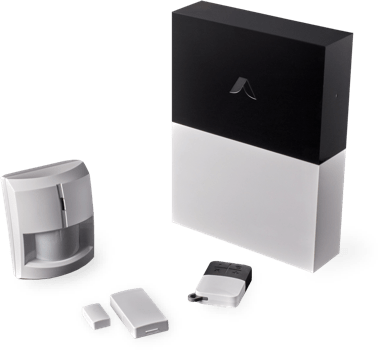
SafeHome.org may receive compensation from some providers listed on this page. Learn More
We may receive compensation from some providers listed on this page. Learn More
Customizable home security with loads of smart home automation features in the “CUE”


When it comes to security equipment, the newest and shiniest isn’t always best. However, abode — a relative newcomer in this space — is quickly becoming one of the best security companies to us.
Why? Because they’re offering some of the sleekest, most well-designed equipment in the industry today. Their new iota Gateway in particular had my inner design senses tingling. In an industry where big, bulky equipment is the norm, abode is really setting themselves apart.
I recently purchased an abode kit and spent about 75 hours testing it. What was the verdict? Let’s say it was somewhere between “well that’s neat,” and “holy cow.” While there were some frustrating moments, overall I’ve decided abode is more than a pretty face.
Pro Tip: abode may be the new kid on the block, but Vivint is still our top choice for smart home security. See what it feels like to live with the most intuitive and futuristic security system in our Vivint review.
Let’s see how abode stacks up, and if it has what it takes to rival some of the best DIY home security systems, like SimpliSafe and Frontpoint.
Check out more recommendations from the SafeHome team:
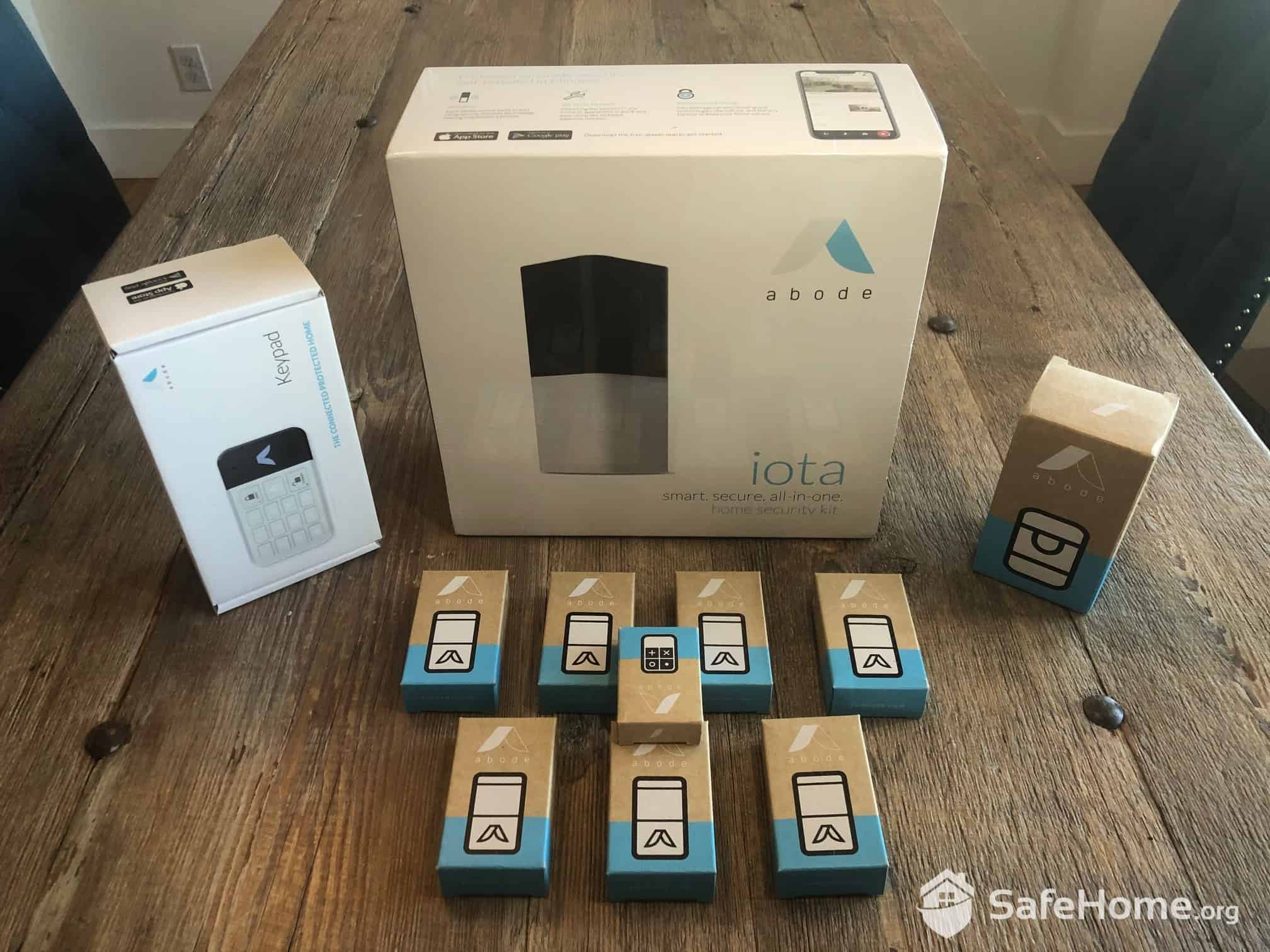
abode Equipment in Packaging
I went with an iota kit that included the all-in-one Gateway hub (iota Gateway), door and window sensors, and a few accessories. Here’s everything that’s included:
This kit set me back $502, which is kind of reasonable for a system of that size. That said, it’s not the most affordable security system I’ve bought. For instance, an Essentials kit from SimpliSafe, which includes one less entry sensor than the abode kit above, costs just $280.
That’s one thing about abode; it may be cheaper than traditional professionally installed systems from the likes of ADT and Vivint, but it’s on the higher end compared to other DIY brands. Still, it’s one of the most affordable security systems around, considering how much value it can add to your smart home security.
It’s also worth noting that the kit mentioned above is no longer available. Since I last tested abode, they’ve streamlined their package offerings down to three kits.
First is the iota All-In-One Security kit that comes with a hub, a door or window sensor, and a keypad for $329. The second one is the $279 Smart Security Kit with all the same equipment, but swaps out the iota for the regular Security Hub. That one costs $279. The third one is the $159 Abode Security Kit, which uses the Security Hub and comes with a key fob and entry sensor.
Pro Tip: abode’s iota security kits start at $329, and they’re worth the extra money to really get the most out of your home security system. As you’ll see, the all-in-one iota Gateway with its built-in HD security camera is impressive, and I think abode’s traditional Gateway could leave you wanting for more.
| abode Kits | Abode Security Kit | Smart Security Kit | All-In-One Security Kit |
|---|---|---|---|
| Hub | Security Hub | Security Hub | iota Gateway |
| Door or window sensor | 1 | 1 | 1 |
| Motion sensor | 0 | 0 | 0 |
| Key fob | 1 | 1 | 1 |
| Price | $159.99 | $279.99 | $329.99 |
Overall, the buying process went smoothly. However, if I were to have one gripe, it’d be that the kits can somehow still be confusing although there are only three options. I suggest double checking your order before clicking the checkout button. The pictures for the different kits kind of look alike, so be watchful!
That aside, I didn’t have any problems with my order. A few days later, it arrived on my doorstep well-packed and ready to go.
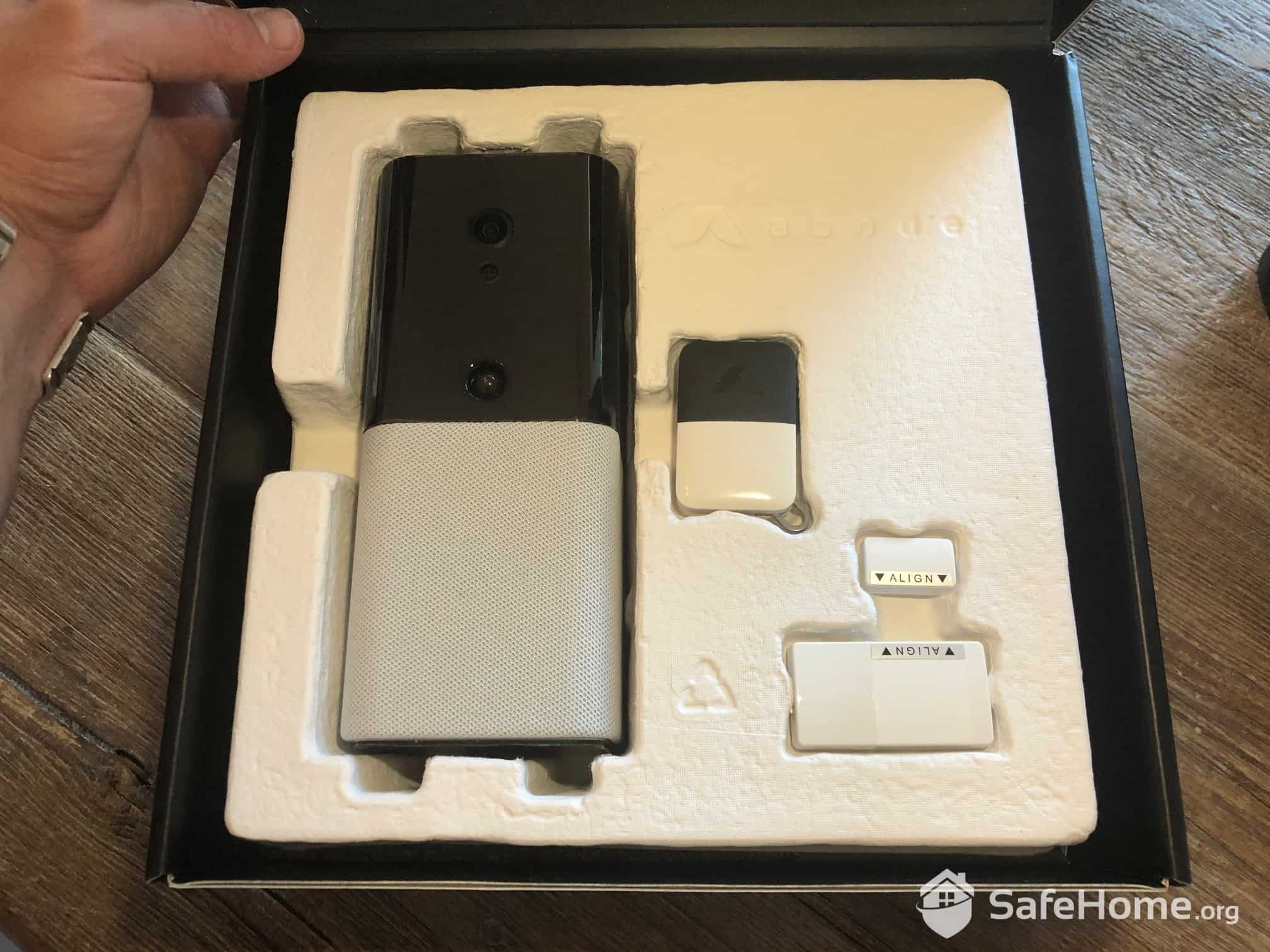
abode All-In-One Gateway Components
Right when I unboxed the iota Gateway, a grin came across my face. Its smooth, glossy, black-and-white motif felt very sleek and modern. It’s the details that abode really gets right, here. From the gateway to the entry sensors right down to the little key fob, it’s all very handsome and well built. The pieces didn’t feel obtrusive or out of place in my home, and I think you’ll be pleased with the design, too.
But of course, you judge a system on more than just looks. So let’s jump into abode’s installation process and features. But first, let’s take care of some Gateway business.
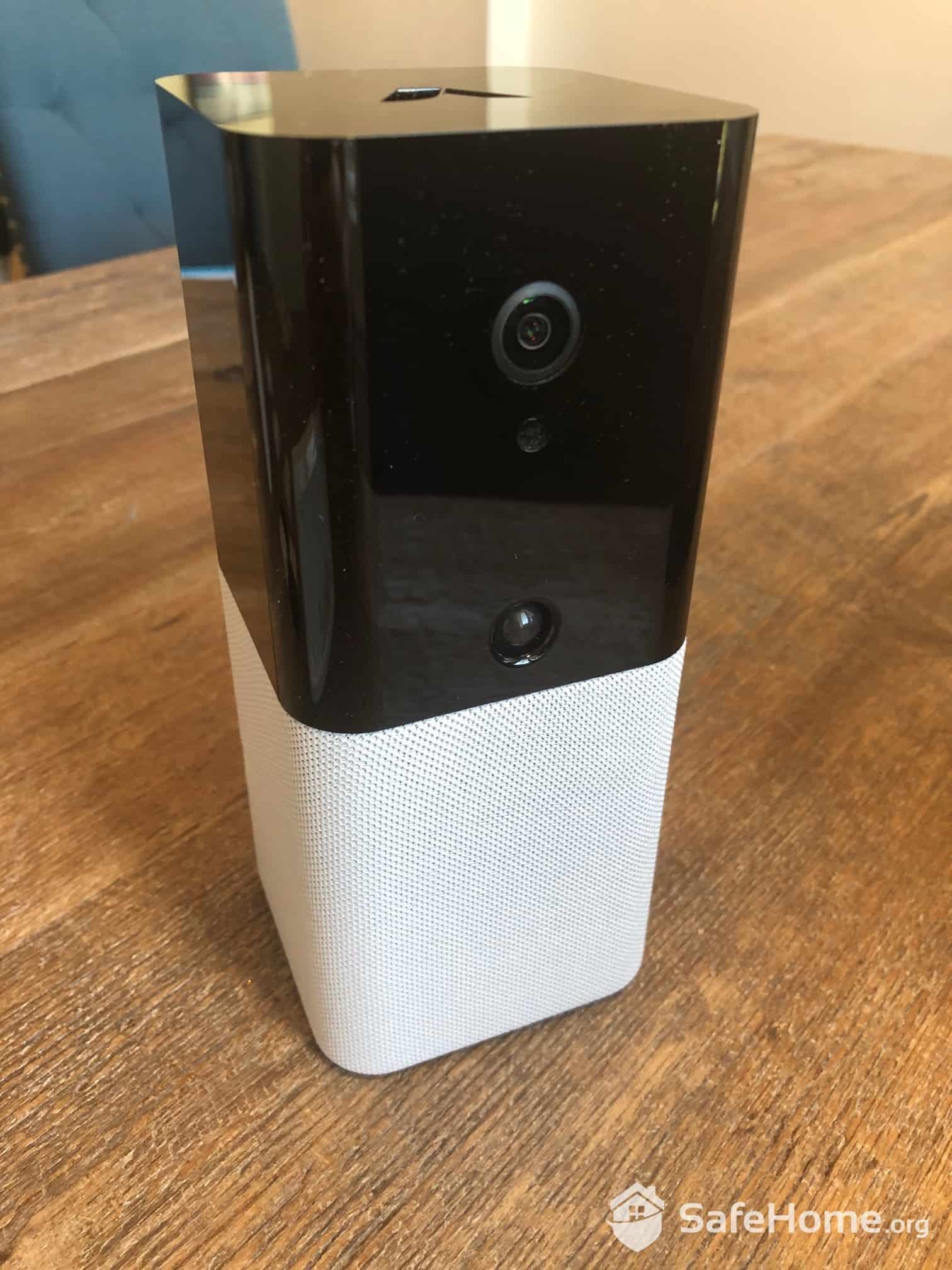
abode Gateway
Plain and simple, the Gateway is your central base station or hub. It’s called the Gateway because of its ability to connect you to a whole world of home automation. But at the end of the day, it’s just marketing speak for a base station.
You have three options with abode, but when I began testing the system, there were only two: the iota Gateway and the Smart Security Hub. The iota comes with a built-in 1080p HD camera with motion detection; the Gen 2 Gateway doesn’t. Otherwise, both units are identical, except that the iota is more compact – hence the name iota, meaning “an extremely smallamount”1 – and it connects to Wi-Fi as opposed to its predecessor that requires an Ethernet connection.
Honestly, the Smart Security Hub looks like an internet router from the ’90s. So the iota Gateway (pictured above) is all-around better looking, and it offers an added layer of video security. Since you’ll likely place the Gateway in a central location, the built-in camera can help you monitor that location without adding an extra device. Plus, it comes with features to stop burglaries, like a motion sensor and a loud siren.
Now, about the third Gateway option, abode recently released the Abode Security Hub. Depending on how you look at it, it’s more or less advanced than the Smart Security Hub. It’s better because it’s Wi-Fi-ready, which means you won’t need an Ethernet cable. At the same time, it lacks HomeKit, Z-Wave, and Zigbee compatibility, which are some of the best features of the Smart Security Hub. Instead, it focuses on Alexa and Google Assistant integrations. For its price ($159 for a basic kit), though, it’s a good deal.
Did You Know? All three hubs support abode’s CUE smart home automation engine. But I prefer the iota for its video capabilities. Plus, the iota packages are only about $100 more. Worth it!
abode prides itself on two things: home automation and DIY setup. So I was expecting a fast and easy installation. This is a big draw, and it’s something that brands like SimpliSafe have dialed-in. (Read our SimpliSafe review to see how easy that system was to install.)
First things first: In your abode box, you’ll find a nifty little card with five steps for setup. It’ll ask you to plug in your Gateway near your internet router, connect your Gateway to your router using the included Ethernet cable, activate the battery backup (using a switch at the base of the Gateway), and then download the app. So far, so easy!
The setup is pretty standard, and for the most part, easy to follow. My biggest complaint is the need to connect it via an Ethernet cable first during the setup process. As I mentioned earlier, one of the advantages of the iota hub is that it can connect to Wi-Fi, but in order to do that, you’ll need to introduce it to your network first via a cable. That’s not very streamlined, but also not a deal-breaker.
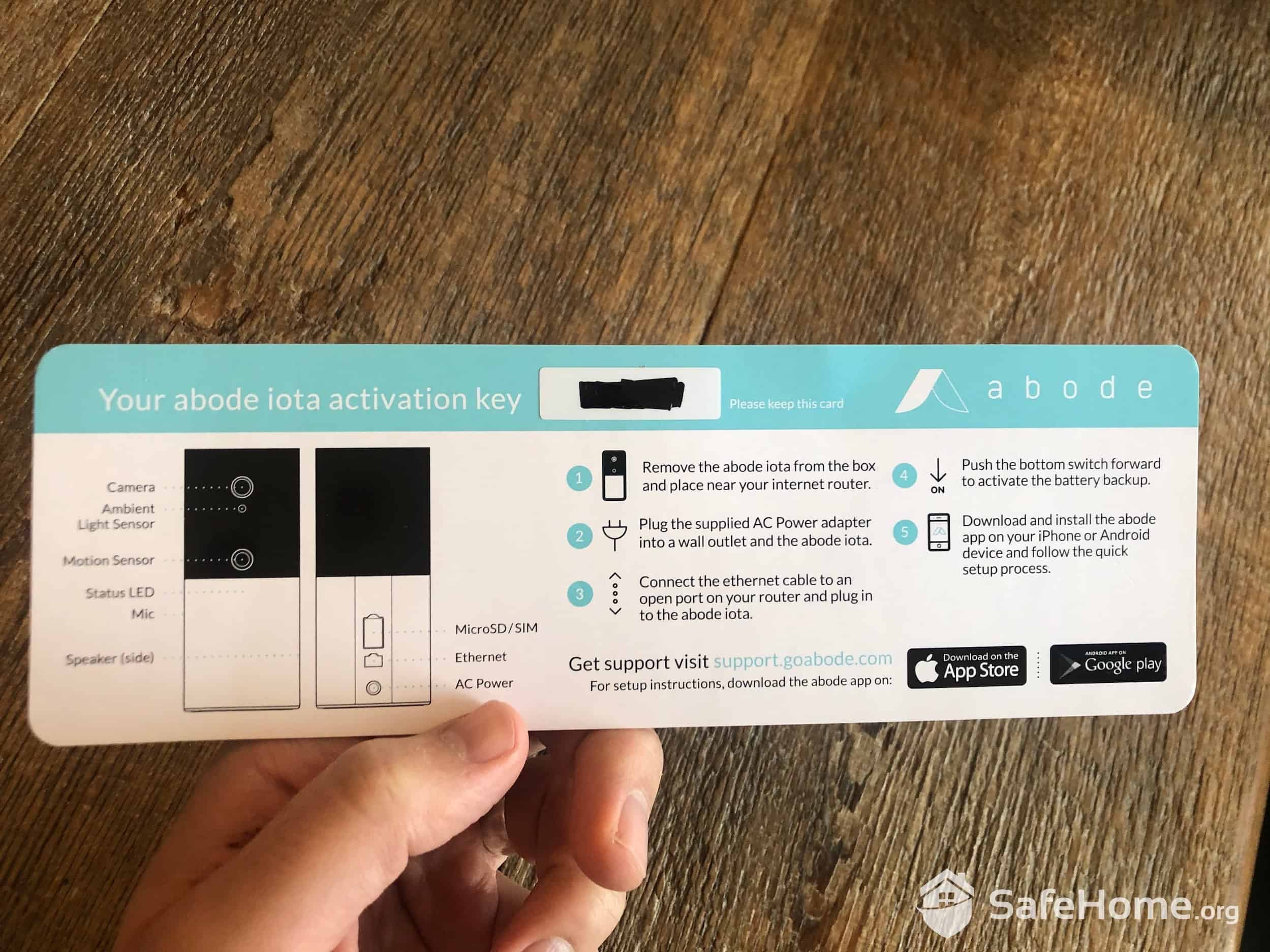
abode iota – Activation
Next, you’ll log into abode’s app or web platform to complete the install. Once you’ve created an account, abode will ask for your activation key, which you’ll find at the top of that nifty little instruction card. Then … voila! You’ll receive the message: “Success! iota connected!”
You can then go around the house and mount the entryway sensors. Note that abode’s mini door/window sensors are some of the tiniest sensors I’ve ever seen. (Remember coins?) They’re even smaller than Ring Alarm’s 2nd Gen sensors, which really surprised me.
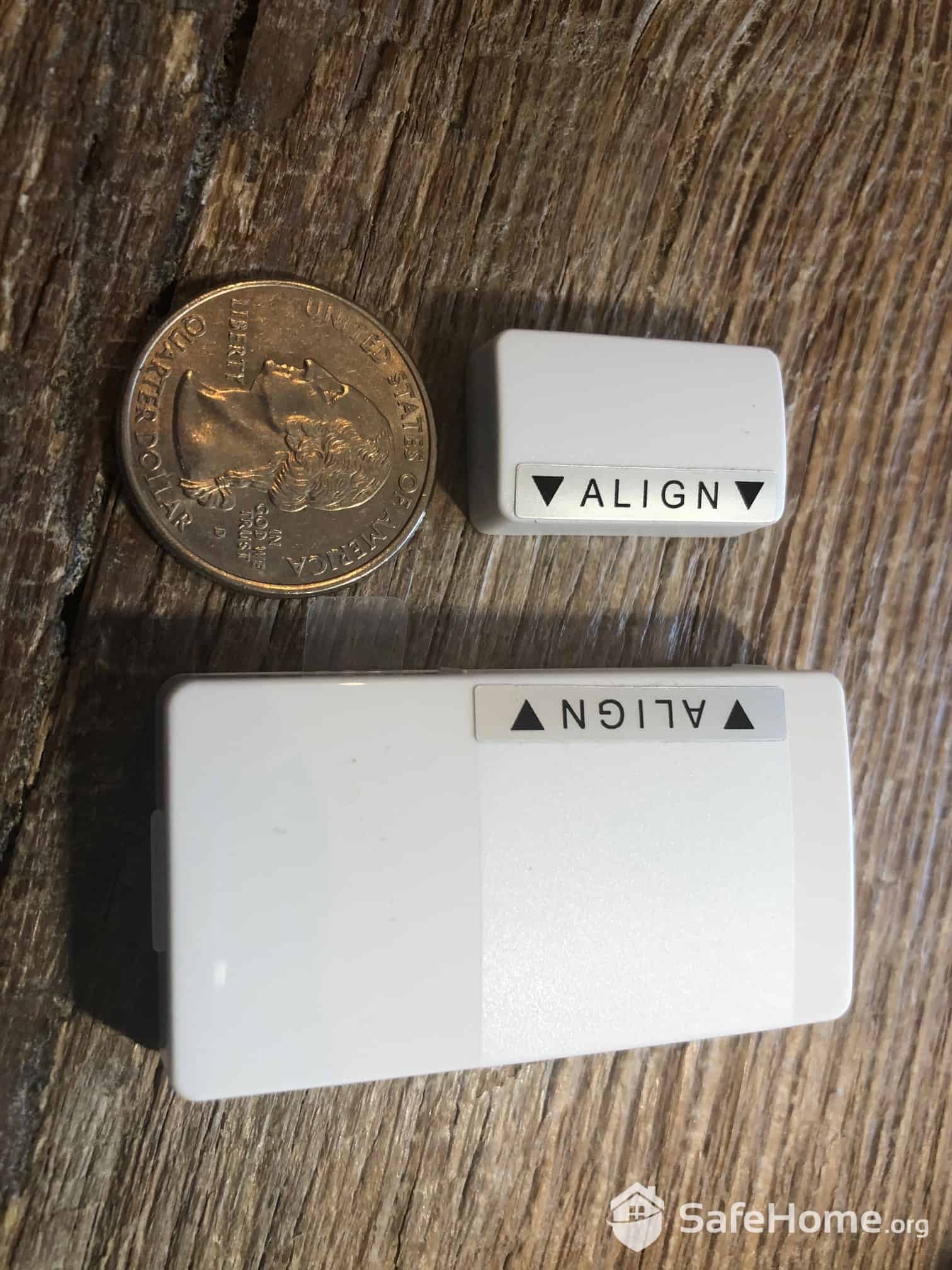
abode Door/Window Sensor Compared to a Quarter
Setting up and installing the sensors is as easy as following the step-by-step instructions provided by abode. The main thing you need to do is pull out the plastic tab to activate each one and stick them in place. Once I did, I hardly even noticed them anymore – they were that low profile.
That said, I didn’t love how passive the hub was. Some feedback would have been nice. There was no chime or anything to let me know that I’d installed and connected the sensors properly. I just crossed my fingers and hoped for the best, which wasn’t the right call.
Turns out, it’s important to press the tiny button on the back of each sensor before mounting, a small detail I must have missed. Anyhow, this only set me back five to seven minutes total. And it’s not unusual to come across small hiccups when installing home security systems, even DIY ones.
As far as the iota Gateway goes, you have the option of keeping it connected via Ethernet2 (most reliable), or switching to Wi-Fi.
The obvious advantage of choosing the Wi-Fi connection over Ethernet is that the Gateway doesn’t need to be buddy-buddy with your router — you can place it anywhere in your home. I had a spot in mind that was nowhere near the router, so I untethered the iota and set it free.
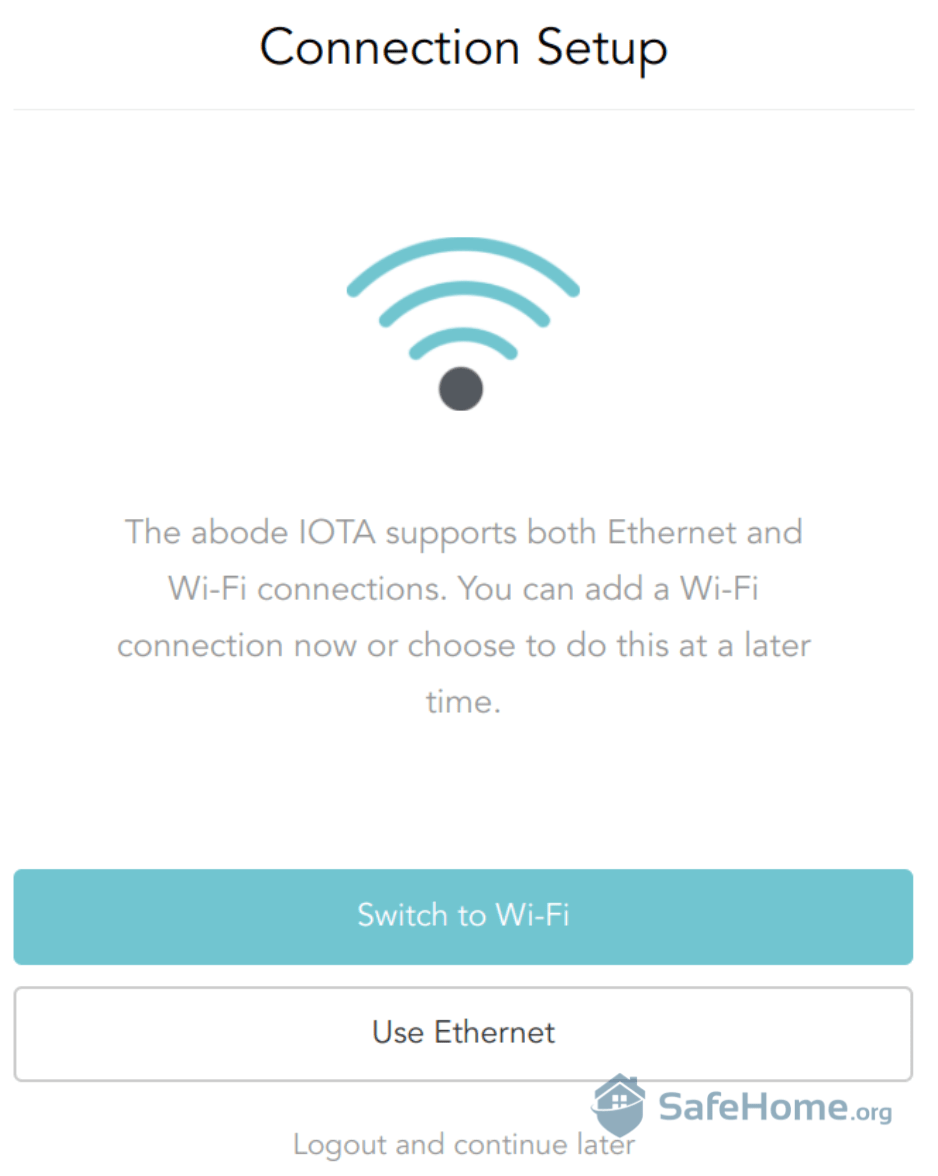
abode Connecting to WiFi
Finally, it was time to choose a subscription plan. This is entirely optional; you can self-monitor abode without having to fork out money for a monthly subscription. But be warned: If you go the self-monitoring route, you’re leaving lots of great features on the table, not to mention the peace of mind you get from 24/7 emergency response from abode’s monitoring center. With professional monitoring, abode’s monitoring center can alert you and the authorities in case of a break-in, making sure you’re always protected whether you’re there to respond yourself or not.
I went with a 30-day free trial of abode’s Pro plan, and I’m glad I did. But more about that in just a bit.
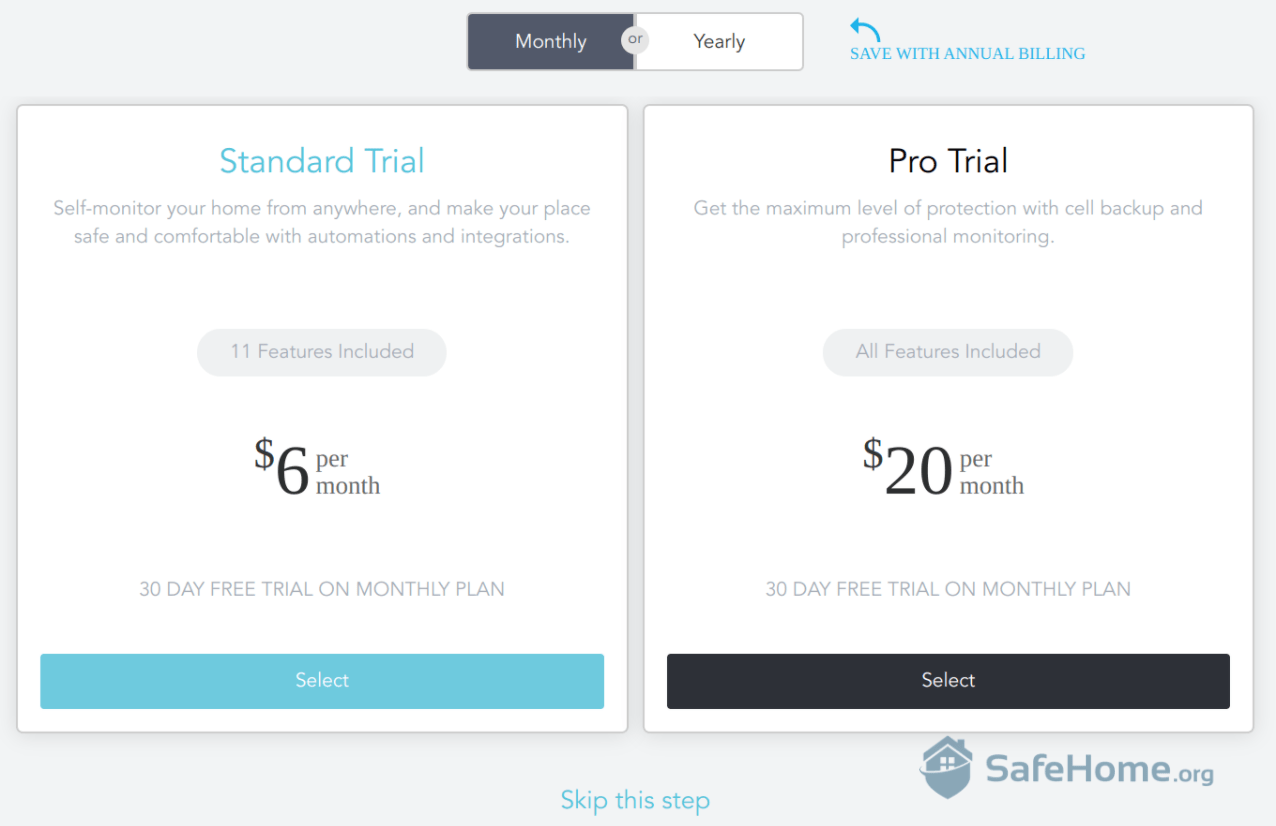
abode Subscription Options
The first day using abode brought some intriguing surprises, to say the least.
Since the iota Gateway has a built-in camera, you’ll want to put a little thought into where you position it. I put mine between my living room and entryway, on a bookshelf with my Ring Stick Up Cam. (If it’s good enough for Ring, then it’s good enough for abode.) That way, I can monitor my living room without adding another security camera. And as I mentioned earlier, the iota also features a motion sensor, so it provides another way to protect my home from burglars, thieves, and other criminals.
Arming and disarming the system is simple, but there’s one thing abode does a little differently than some other brands. Their “disarm” mode is actually called “standby.” This can take a bit to get used to. Just another example of how abode marches to the beat of a different DIY drum.
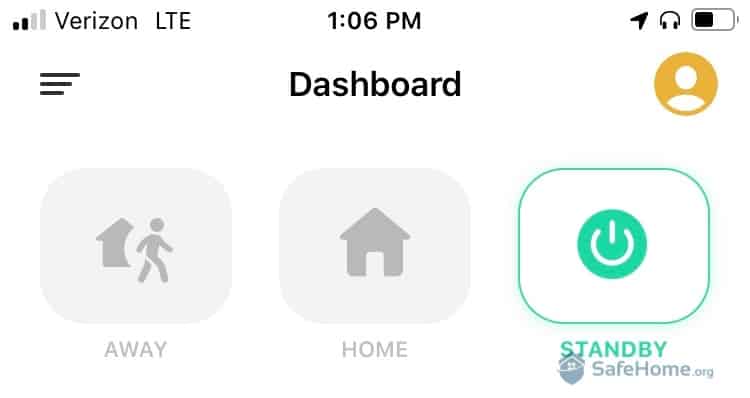
abode App Dashboard
On the app dashboard pictured above, you’ll see your main system controls. You can perform these commands from virtually anywhere in the world using your smartphone. You can also arm and disarm the system using the Keypad 2.0, which you can purchase a la carte for $65.99.
I love the simplicity of the keypad, but at the same time, I feel like a system like abode needs a keypad that’s a bit more advanced – perhaps a touchscreen keypad that can do more than just arm and disarm the system. As I’ll get to later on, abode has some of the best home automation features I’ve seen in my years of testing DIY security systems, and abode would have been able to capitalize more on that if they had a more advanced keypad.
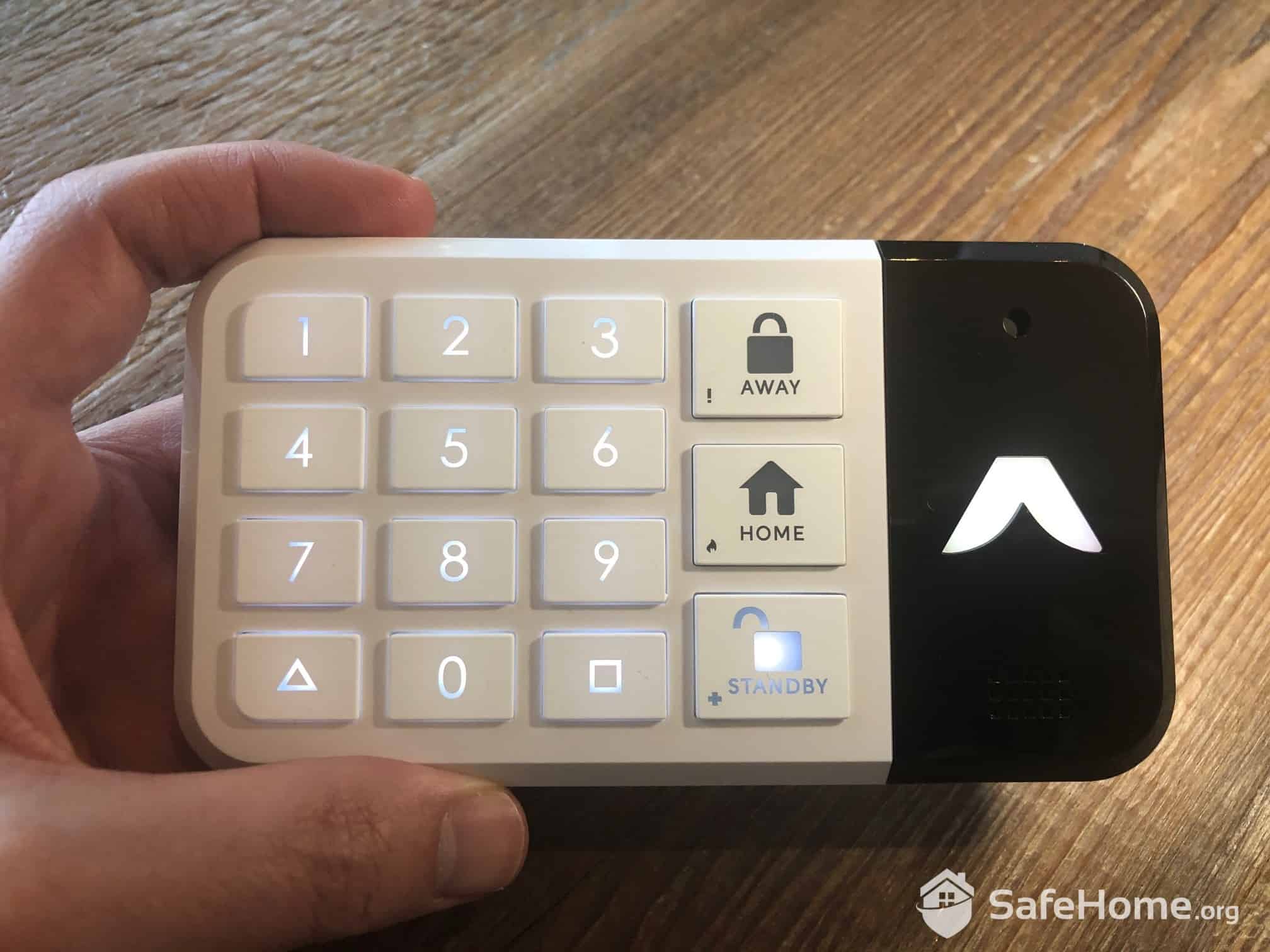
abode Keypad
I placed the keypad in my entryway, but to be honest, I hardly ever used it. I mainly controlled the system using my iPhone and the key fob that came in the box. (More on that nifty little guy in a bit.)
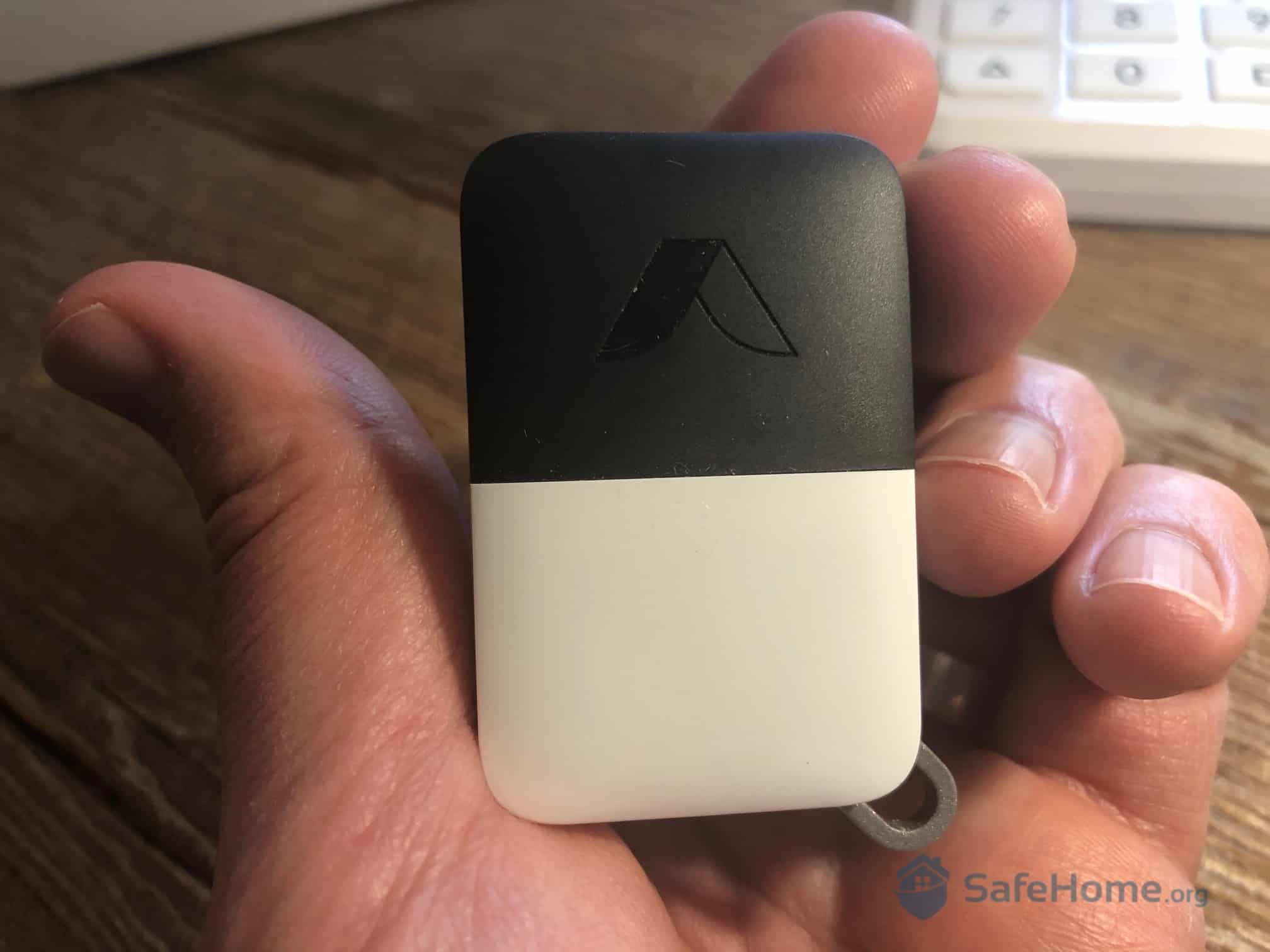
abode Key Fob
Now one thing that you might have to get used to is that the Gateway makes a lot of noise. And no, I’m not talking about fans or the occasional clicks you get from harddrives. This thing sounds like R2-D2. So much so that I found myself asking it where C-3PO was.
The good news is if you’re frustrated by the chatter, you can jump into your systems settings and “mute all sounds,” or customize it to only start chirping when you want it to. Highly recommended.
Did You Know? abode works with Bose speakers — the first collaboration of its kind. If you have Bose speakers, you can integrate with abode to set unique chimes, crank up the volume of your siren, and perform other helpful functions through the ol’ woofers. You can even automate the speakers to play your favorite playlist anytime you want. “Hamilton” soundtrack, anyone?
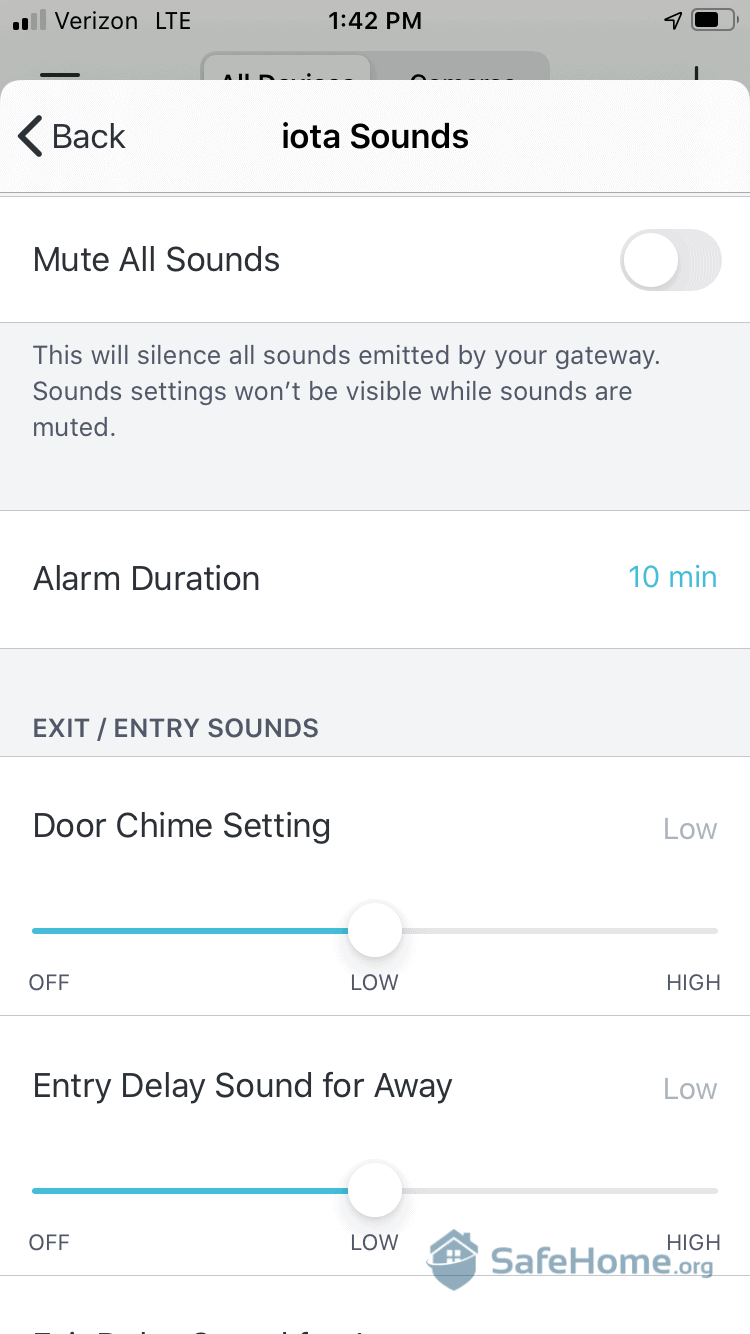
abode iota Sounds
You’ll also be able to customize the entry and exit delays. If you’re not familiar, a “delay” is the time the system gives you to get out of (or into!) your home without the alarm sounding. Some systems require a minimum 30-second delay, but in my eyes, long delays only spell bad news.
For instance, if you have a one-minute entry delay, that gives an intruder enough time to have a field day before hightailing it out of there. Even 30 seconds is enough time for a thief to grab-and-go. I’m happy to say that abode offers more delay customizations than any other system I’ve tried.
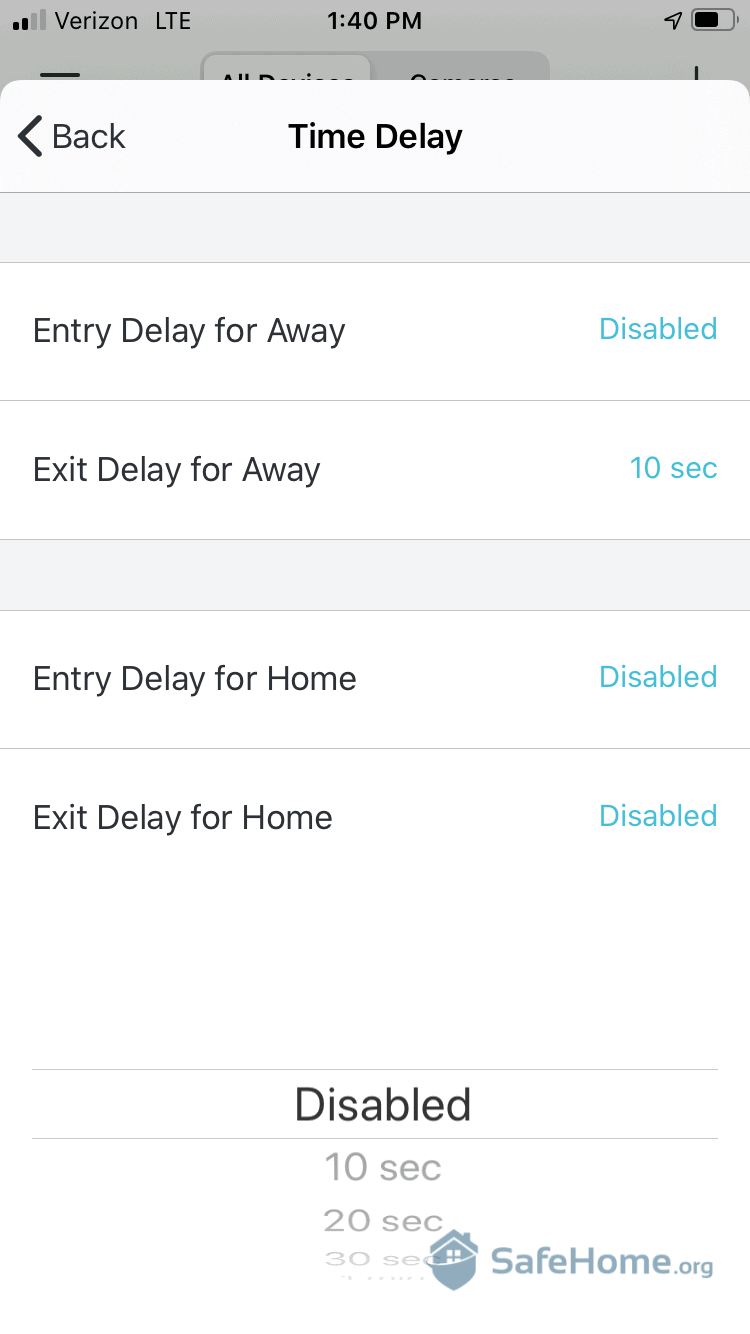
abode App – Arming the System
Every time you arm or disarm (or standby) your system, the iota Gateway will use the built-in camera to capture a short video clip, which then posts to your timeline in the app. That’s a nice little feature, especially if you have roommates. With it, you can see exactly who armed and disarmed the system, and the more you know, the better you can protect your home.
I’d like to note that that’s a feature we don’t normally see in other security systems, even if they have indoor cameras too.
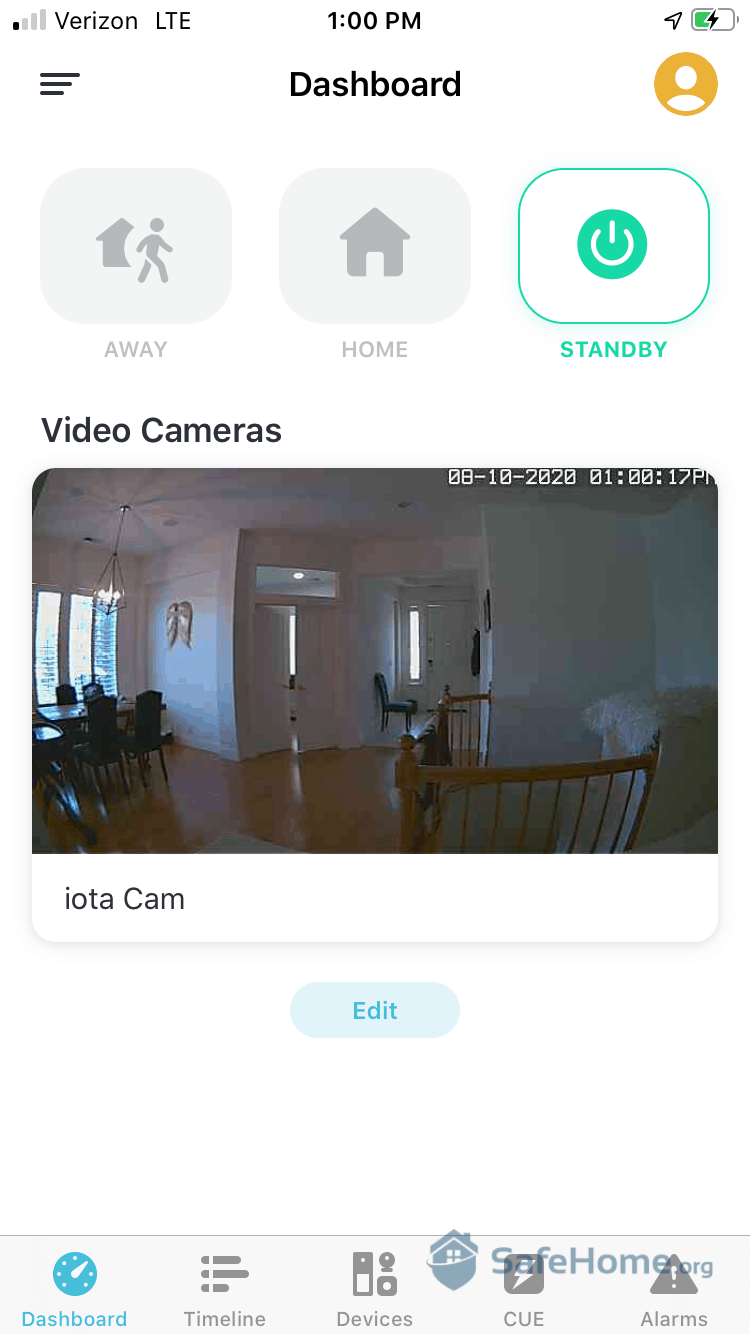
abode App Video
If you’re in the market for an add-on cam, abode offers two of them with 1080p HD resolution: the abode Cam 2 and the Outdoor Smart Cam. They both have two-way talk, weatherproofing, person detection (more about that later), and full-color night vision. The Outdoor Smart Cam can even be mounted as a video doorbell.
These cameras integrate well with the overall abode system. Through the CUE home automation engine, for example, you can set an outdoor camera to start recording when your front door is opened. That way, you can capture the identity of a potential intruder. So this is a great feature for protecting your home and family.
By default, though, the cameras are set to record when they detect motion or people.
Pro Tip: Learn what to look for, how much to pay, and more in our buying guide for home security cameras.
| Features | abode Cam 2 | Outdoor Smart Cam |
|---|---|---|
| 1080p HD Resolution | Yes | Yes |
| Person Detection | Yes | Yes |
| Two-Way Voice Enabled | Yes | Yes |
| Weatherproof | Yes | Yes |
| Wi-Fi Enabled | Yes | Yes |
| Full Color Night Vision | Yes | Yes |
| Compatible With Amazon Alexa and Google Assistant | Yes | Yes |
| Doorbell Mounting | No | Yes |
| Price | $59.99 | Pre-order |
| Sale Price | $26.99 |
Now for a lightning round of my favorite abode features. This will give you a sense of what it’s really like living with abode.
Even if you typically like to control your system using your smartphone, you’ll appreciate how abode’s web platform lays everything out in a way that makes it easy to find what you need. Most security systems offer a web interface (Frontpoint is our favorite), but the design is usually pretty uninspiring. I think abode has it dialed-in here. Have a look …
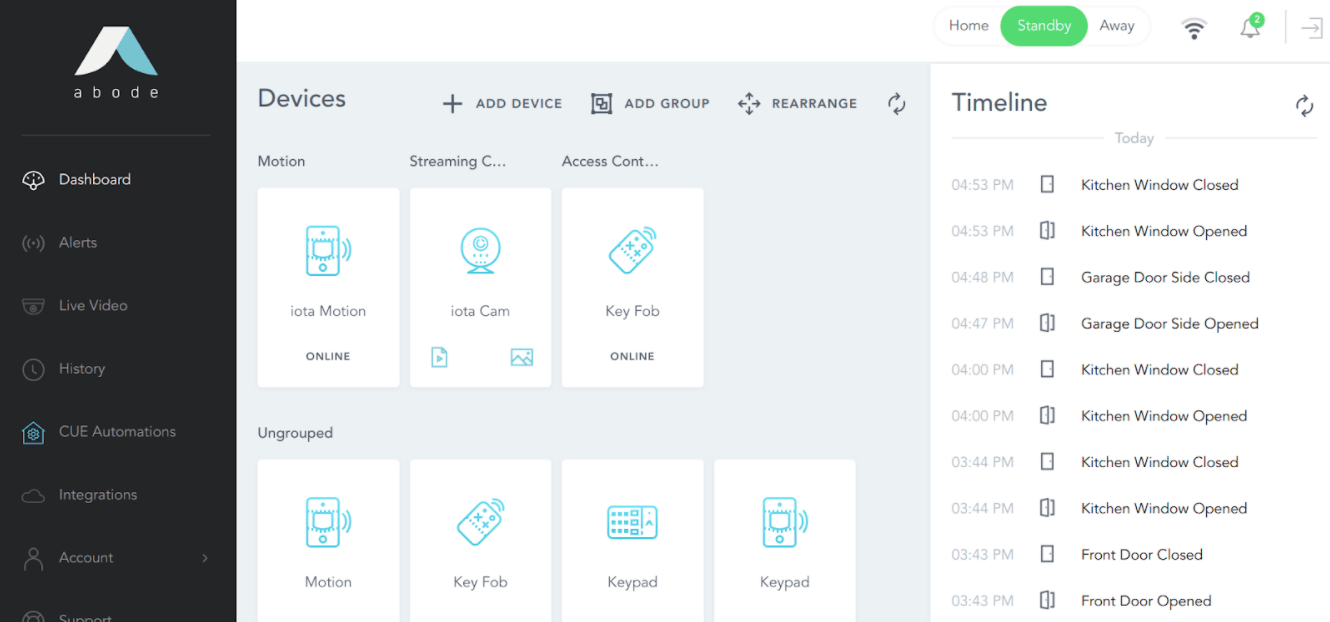
abode Web Dashboard
CUE is easily my favorite thing about abode. CUE is a native home automation platform exclusive to abode. It’s like IFTTT, just built right into the app and ready to go.3 You’ll really like the feature set here, especially if you’re a smart home aficionado like me. (And if you are, I recommend checking out our guide to the best home automation security systems.)
So … what exactly does CUE do?
First off, it’s where you’ll set up and manage your home automations. At my house, that includes smart lights, as well as a garage door sensor. Using CUE, I was able to integrate these devices and set custom automations to do my bidding.
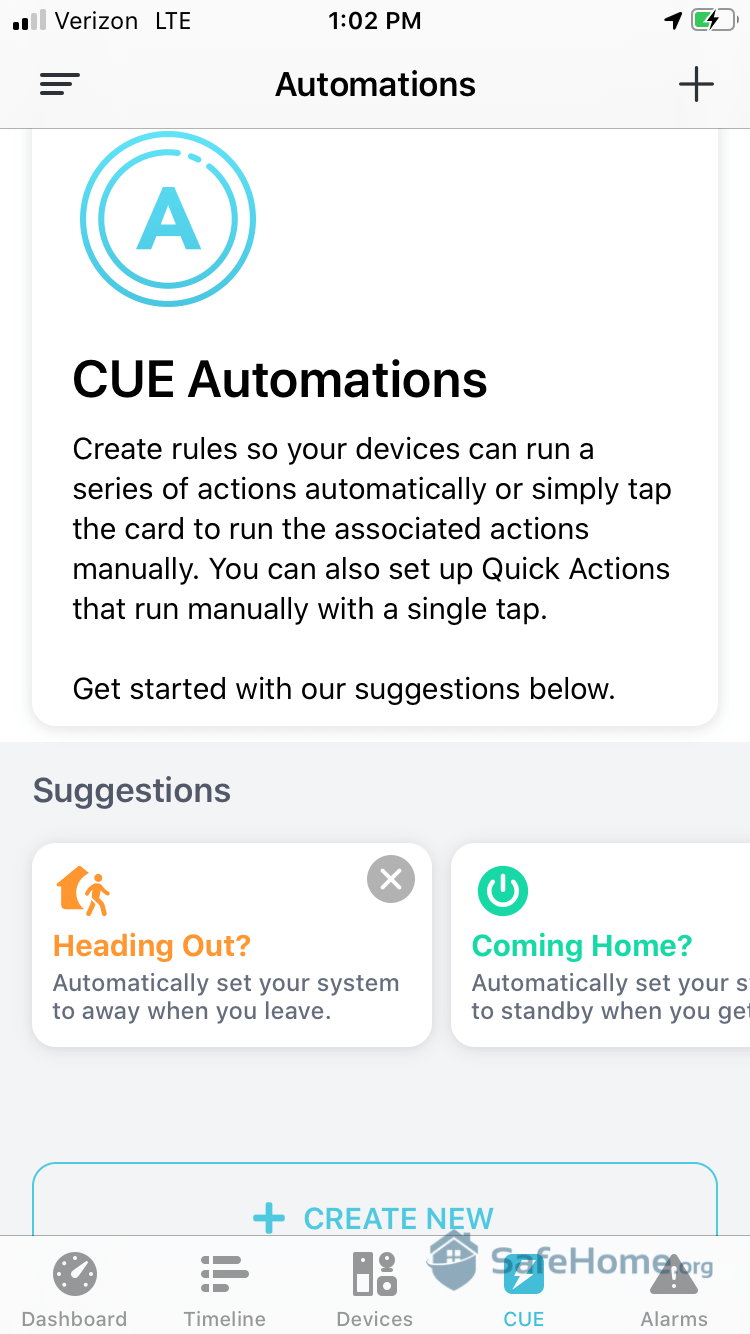
abode CUE Automation
For instance, I created an automation that armed the system 15 minutes after sunset. The sun sets about 9 p.m. in my area, and by that time I’m cozied up with Netflix anyway.
I also set the smart lights to automatically dim after sunset. And I set the garage door to close whenever I left my “geofence,” which is a 600-foot radius around my house. The abode system does all of this behind the scenes, while also keeping intruders out via the perimeter alarm. Not bad.
It’s impressive how granular you can get with “triggers” and automations.4 And it’s really handy having them as “Quick Actions” right on your dashboard. Once you create an automation, all it takes is a simple tap-of-the-screen to activate. Pretty slick!
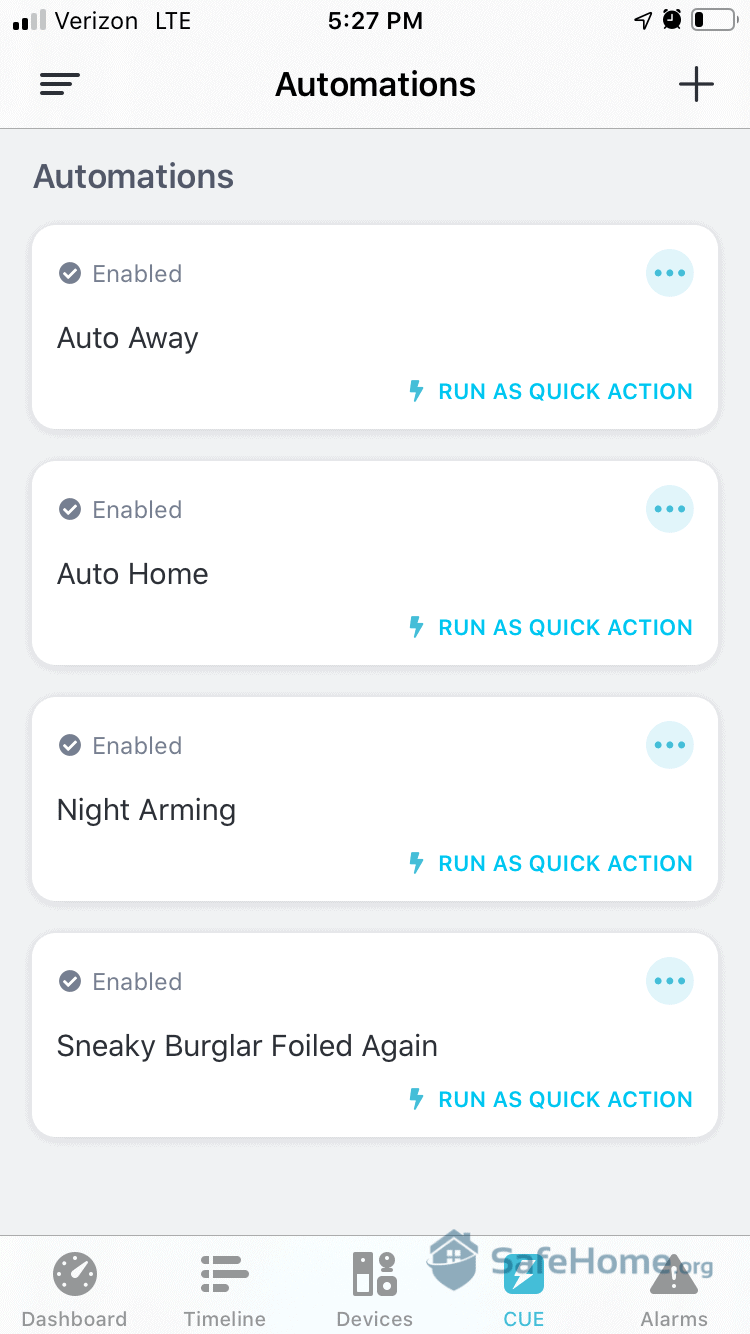
abode App Automation
As far as smart home automation goes, abode is a few steps ahead of other DIY home security systems. And it’s all thanks to CUE.
It’s worth mentioning that I wish abode offered a touchscreen control panel (like Vivint!). As it stands, you’ll have to create and manage your automations using your smartphone, a mobile device like an iPad, or your desktop/laptop. Not the end of the world — but is a touchscreen panel too much to ask?
FYI: Smart home automation means you really won’t have to think about your system after you program it. Just “set it and forget it.” And CUE delivers in spades.
Geofencing is a feature that uses your smartphone’s GPS to create a virtual “fence” around your home.5 You can set abode to perform a specific function when you cross your geofence. I talked about geofencing in my Frontpoint home security review, because their system offers nice geofence arming reminders. But abode takes things a step further and actually arms the system for you.
This is helpful for those of us who sometimes forget to set the alarm when leaving for the day. With geofencing, you never have to worry about it. (Just be sure this “auto alarm” feature doesn’t arm your house when your spouse is still at home. Oops!)
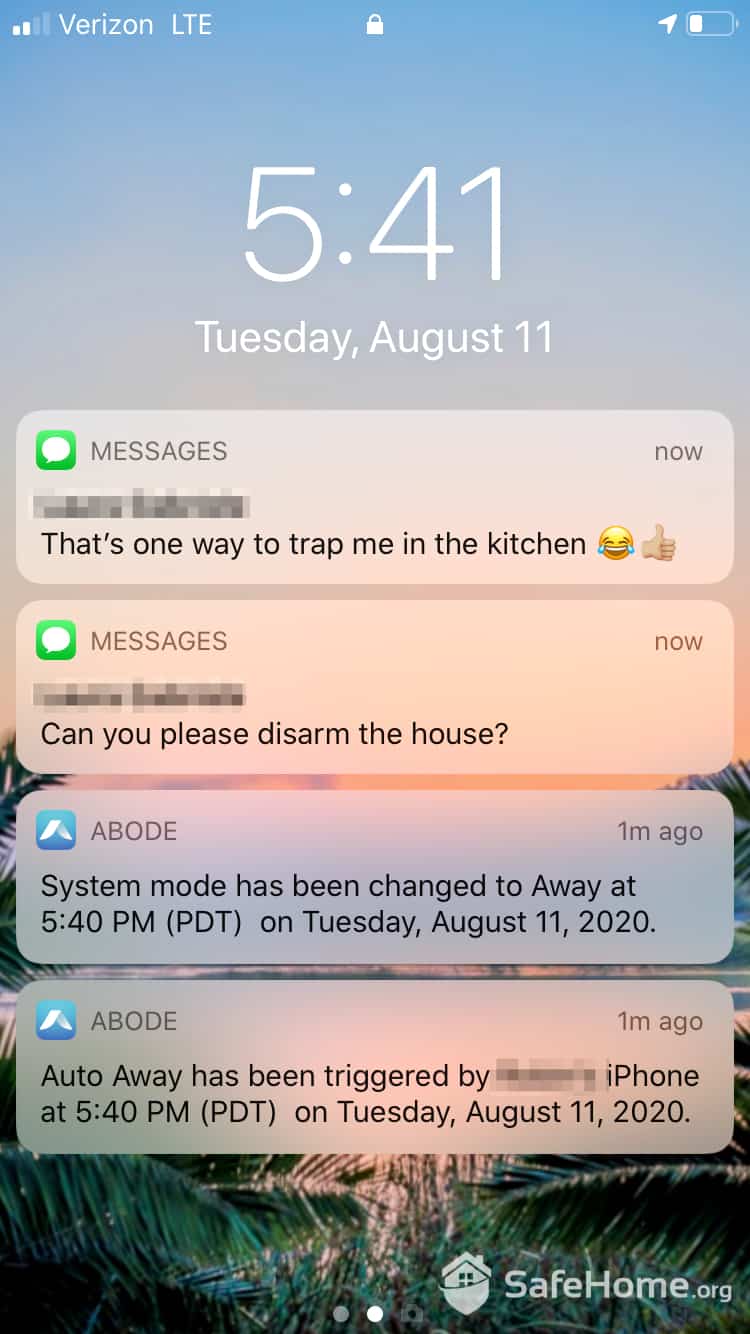
abode Notifications
abode’s key fob is quite the looker! It’s about 25 percent smaller than my car key fob, and it has that modern two-tone, black-and-white design. If someone sees it on your keychain and asks what you drive, just tell them you drive an iota. It even sounds like a car!
Unfortunately, the button symbols on the key fob take some getting used to. One night I pressed “Away” meaning to hit “Home,” and within five minutes my motion sensor triggered the alarm and woke my little one. That’s one mistake that will never (ever) happen again. Overall, I really enjoyed using abode’s key fob. It definitely got a lot of miles.
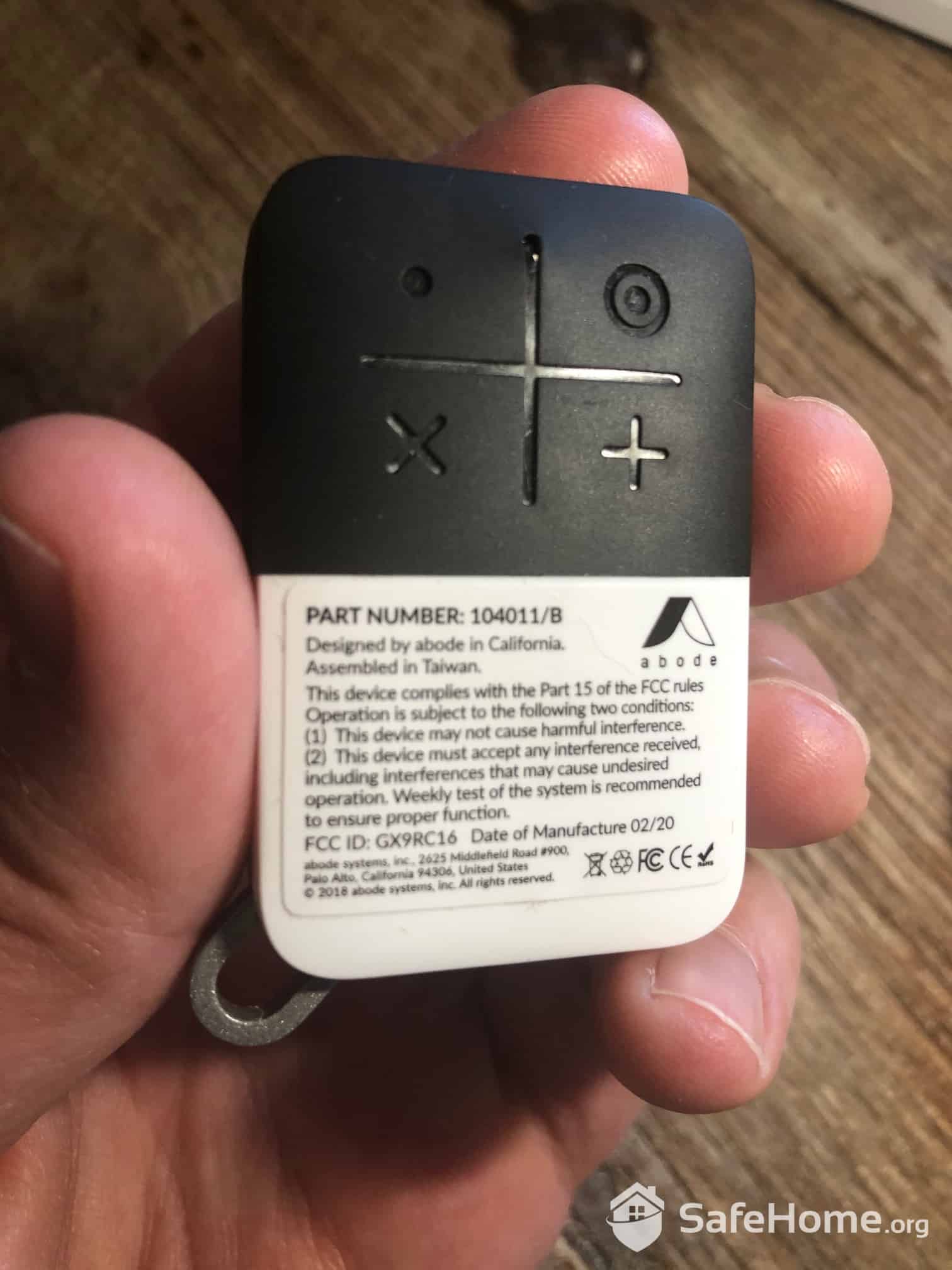
abode Back of Key Fob
When it comes to security cameras, you always want to look for a resolution of at least 1080p HD, a 120-degree field of view, and two-way talk. The iota camera checks all the boxes. And it’s great that it’s built right into the main hub. That means less security equipment inside the home.
abode also just rolled out a new person detection feature in the iota smart hub and their stand-alone cameras. This takes those cameras to a whole new level of intelligence. When someone approaches (or enters!) your home, you’ll get an instant mobile notification with a short clip of the activity. New “person” tags will appear on your timeline in the app, and you’ll be able to go back and review the clip for as long as your storage plan allows.
FYI: I like abode’s new person detection feature; however, remember that person detection and facial recognition are two different things. abode doesn’t offer facial recognition (yet), which is advanced AI-powered functionality. You’ll only find this feature in top-shelf cams like the Nest Cam IQ. (Read about facial recognition in our Google Nest Cam IQ review.)
The iota has motion detection, too. But that’s standard these days. The iota’s motion detection feature will trigger the alarm while armed in “Away” mode. And any time it senses motion, a 30-second video clip will be recorded and sent to your smartphone as an instant notification. You can fine-tune your video alerts in the abode app.
The video quality is sharp, and I only noticed a one-second lag while streaming live video. Even in low-light conditions it worked pretty well. (See the snapshot below.)
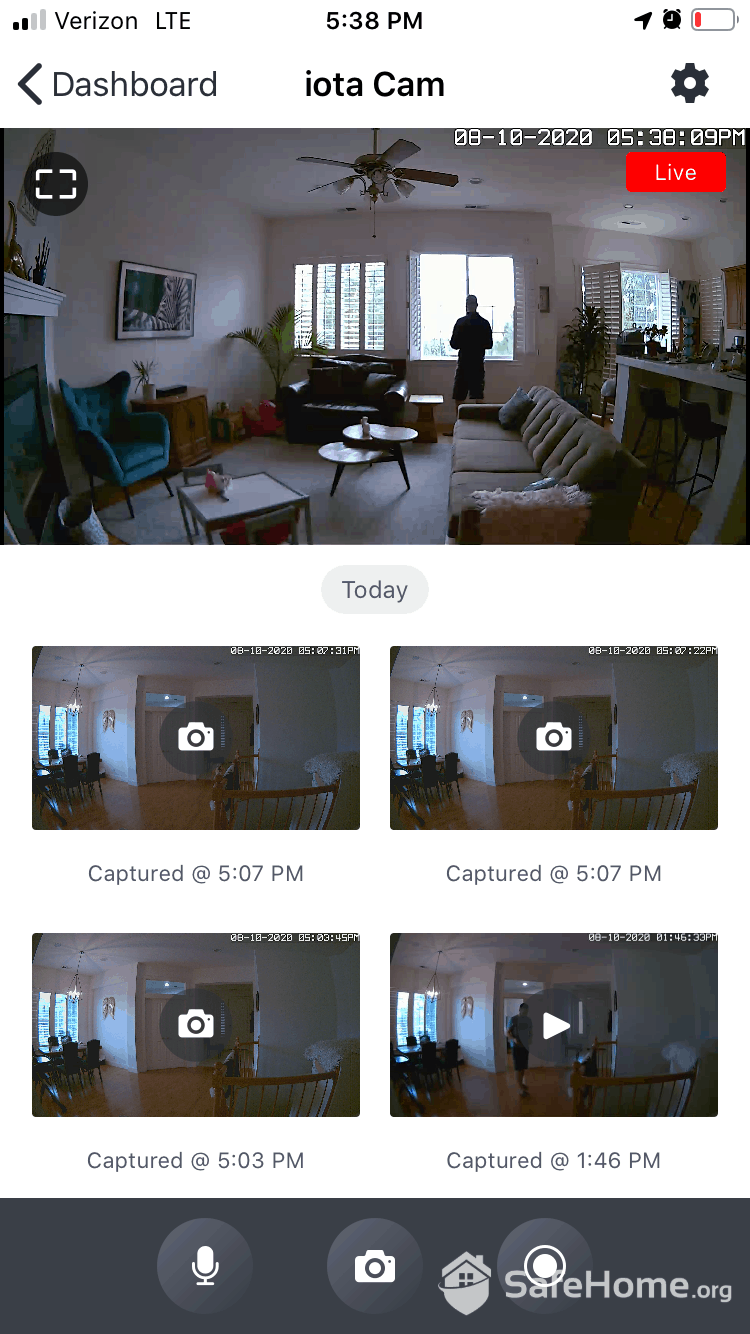
abode App – Video Recordings
As mentioned, you’ll be able to adjust the video length and resolution within the app’s settings, which is a nice little touch that you don’t see very often. Note that high-resolution footage will take up more storage space and use more bandwidth.
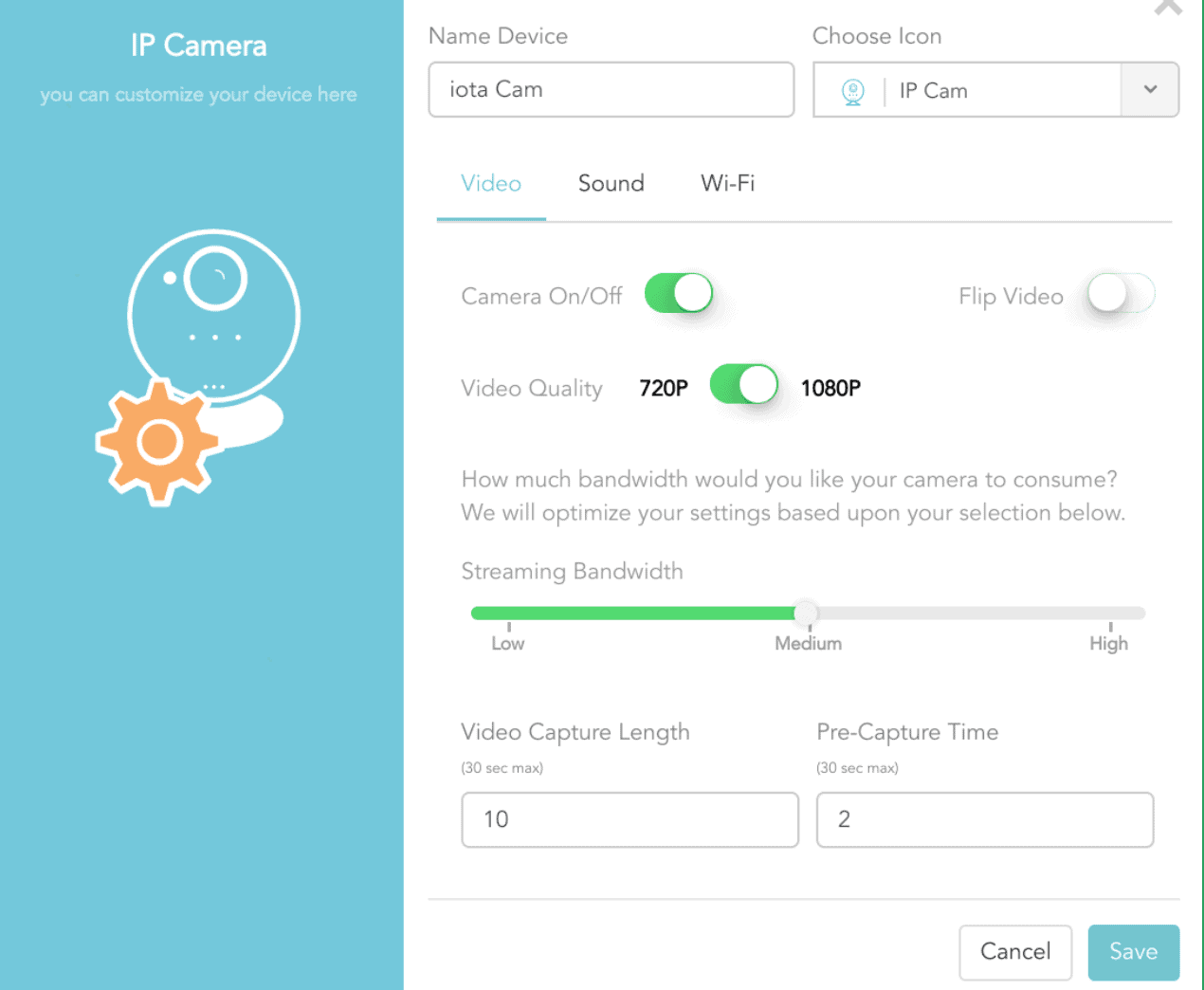
iota Cam IP Camera
I loved abode’s simple aesthetic and minimalist hardware, but with features as advanced as it offers, I didn’t enjoy the user experience with the push-button keypad. It was decent, but a touch-screen control panel would have offered a better user-interface and more functions. So hopefully abode adds a modern panel to their lineup soon. In the meantime, at least you’ll have the well-designed mobile app and key fob to control the system.
Another thing I don’t love is that abode’s starter kits only come with one entryway sensor. Even if you live in a 400-square-foot studio apartment – which very much still needs a security system – chances are you’ll have a front door to protect and at least one window (hopefully). Most likely, you’ll have several entry points to secure, which means you’ll have to add additional sensors to your order.
FYI: If you go with a starter kit, you’ll likely have to add extra sensors to your order. Thankfully, abode sells extra sensors for a reasonable price. And abode’s sensors are on sale right now. The mini sensor is $19.99 and the recessed sensor is only $27.99. All the more reason to go with abode.
I did experience some setbacks while installing abode, so the process could be a little more intuitive. But honestly, a few bumps are to be expected with any DIY project. I’ve tested and set up dozens of DIY security systems, and by far, abode was one of the easiest to install.
As a side note, if you want the flexibility and affordability of a DIY system like abode, but don’t want to roll up your sleeves, you can pay $99 at checkout for professional installation. So you have options.
Now we talked about abode’s native smart home automation chops using CUE. But what about integrations? If you’re a smart home buff (or want to be), you should know that abode integrates with 160 devices from a handful of third-party platforms. I didn’t push my iota to its limits here, but I can say that it trumps other DIY brands in the home automation category.
Other systems might play well with Alexa and Google Assistant for voice control, and maybe Z-Wave or Zigbee (if you’re lucky). But abode works with Z-Wave, Zigbee, IFTTT, Nest, Philips Hue, Apple HomeKit, Yale, Schlage, Bose, and the list goes on. Seriously, what more do you need?
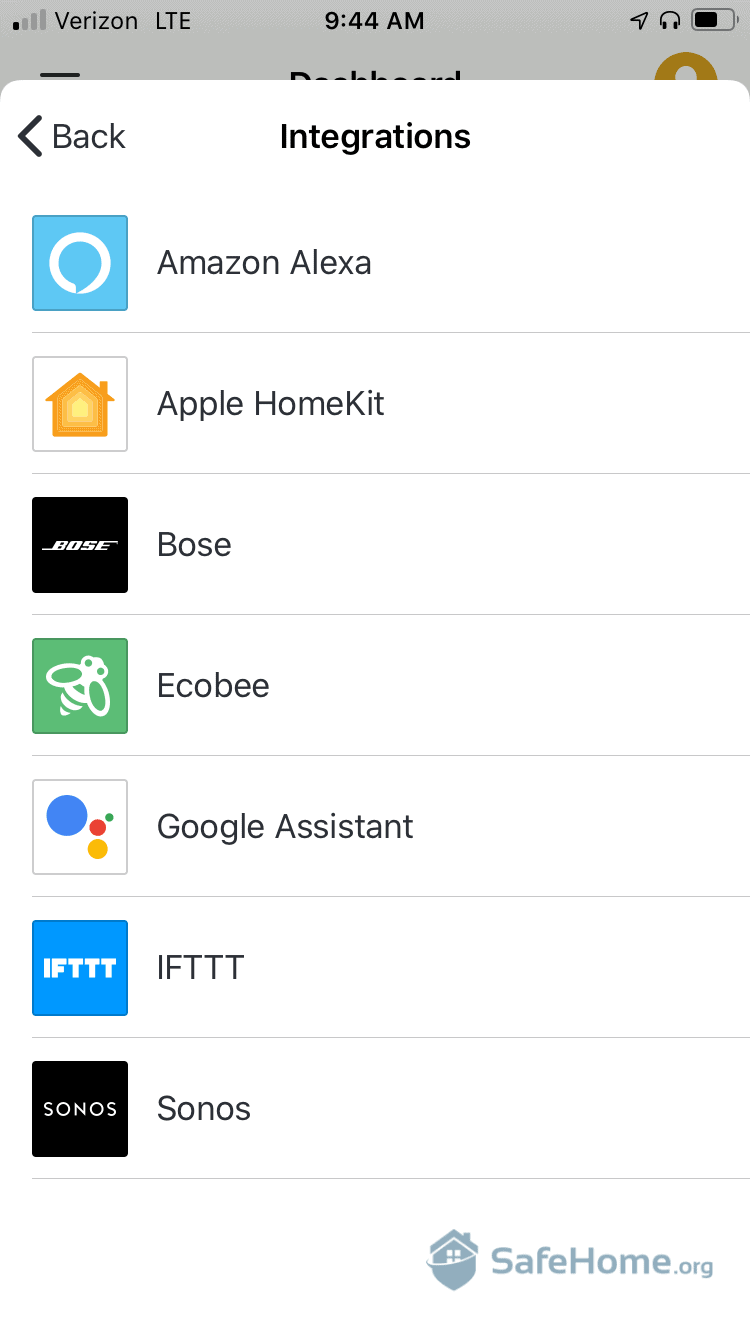
abode Smart Home Integration
| System communication | Internet (cellular backup available with a plan) |
|---|---|
| Monitoring type | Free and paid self-monitoring, optional professional monitoring |
| Self-monitoring alerts | App, text, email, and siren |
| Response time | 20-30 seconds |
| Installation | DIY (pro installation available) |
| Control panel | Hub with wireless keypad |
| Sensor options | Motion, entry, recessed door, glass break, etc. |
| Indoor and outdoor cameras | Yes |
| Home coverage | Up to around 3,000 square feet |
| App compatibility | iOS and Android |
| Equipment warranty | 1-year |
| Monitoring contract | Month-to-month |
| Professional monitoring cost | $21.99 per month |
| Equipment cost | Starting at around $250 |
| Equipment financing | Available through Bread |
| Release date | 2018 |
Like most DIY home security companies, abode keeps things simple with their subscription plans. There are three options to choose from: Basic, Standard, and Pro. The Basic plan is included for free, but doesn’t offer 24/7 monitoring or any of the advanced features that really make abode worth it.
I recommend springing for a paid plan to unlock features like CUE automations, instant alerts, video recording, and of course, 24/7 professional monitoring.
One really big downside of abode is that even though abode advertises itself as a potential no-monthly-fee solution with self-monitoring, the free plan just doesn’t get you enough features. You’ll receive notifications and be able to stream your cameras, but when things like an internet outage occur, the free plan won’t give you cellular backup, for instance. The paid subscriptions will solve those potential issues that might arise.
Here are the latest abode security system plans and prices, and the benefits of each.
| Features | No Plan | Standard Plan | Pro Plan |
|---|---|---|---|
| Cameras Supported | Individual | Unlimited | Unlimited |
| Live and Recorded Video | Yes | Yes | Yes |
| Motion Detection | Yes | Yes | Yes |
| Image Capture | Yes | Yes | Yes |
| Notifications | Yes | Yes | Yes |
| Video Storage | No | Yes | Yes |
| Timeline | No | Yes | Yes |
| Home Automation | No | Yes | Yes |
| In-App Panic Alarm | No | Yes | Yes |
| Premium Support | No | Yes | Yes |
| Person Detection | No | Yes | Yes |
| Exclusive Deals | No | No | Yes |
| Cellular Backup | No | No | Yes |
| 24/7 Professional Monitoring | No | No | Yes |
| Monthly Price | Free | $6.99 | $21.99 |
| Annual Price | Free | $65.99 | $219.99 |
As far as 24/7 professional monitoring goes, abode is a little more expensive than some other popular DIY systems. For instance, Ring Alarm pricing runs as low as $10 per month, and SimpliSafe pricing starts at $19.99 per month for basic professional monitoring.
But for $21.99 per month (or the discounted rate of $219.99 per year), you can get abode’s Pro plan, which includes 24/7 professional monitoring, video support, and smart home automation.
Pro Tip: Take advantage of abode’s 30-day free trial of the Pro plan. If you’re not happy with it, just cancel within the 30-day trial period and you won’t be charged.
Before moving on, it’s worth mentioning that both abode Gateways offer local video storage for free. This means you can pop in a micro SD card and store video clips on the camera itself. On the iota, you’ll find the SD slot on the back of the device, just above the Ethernet port.
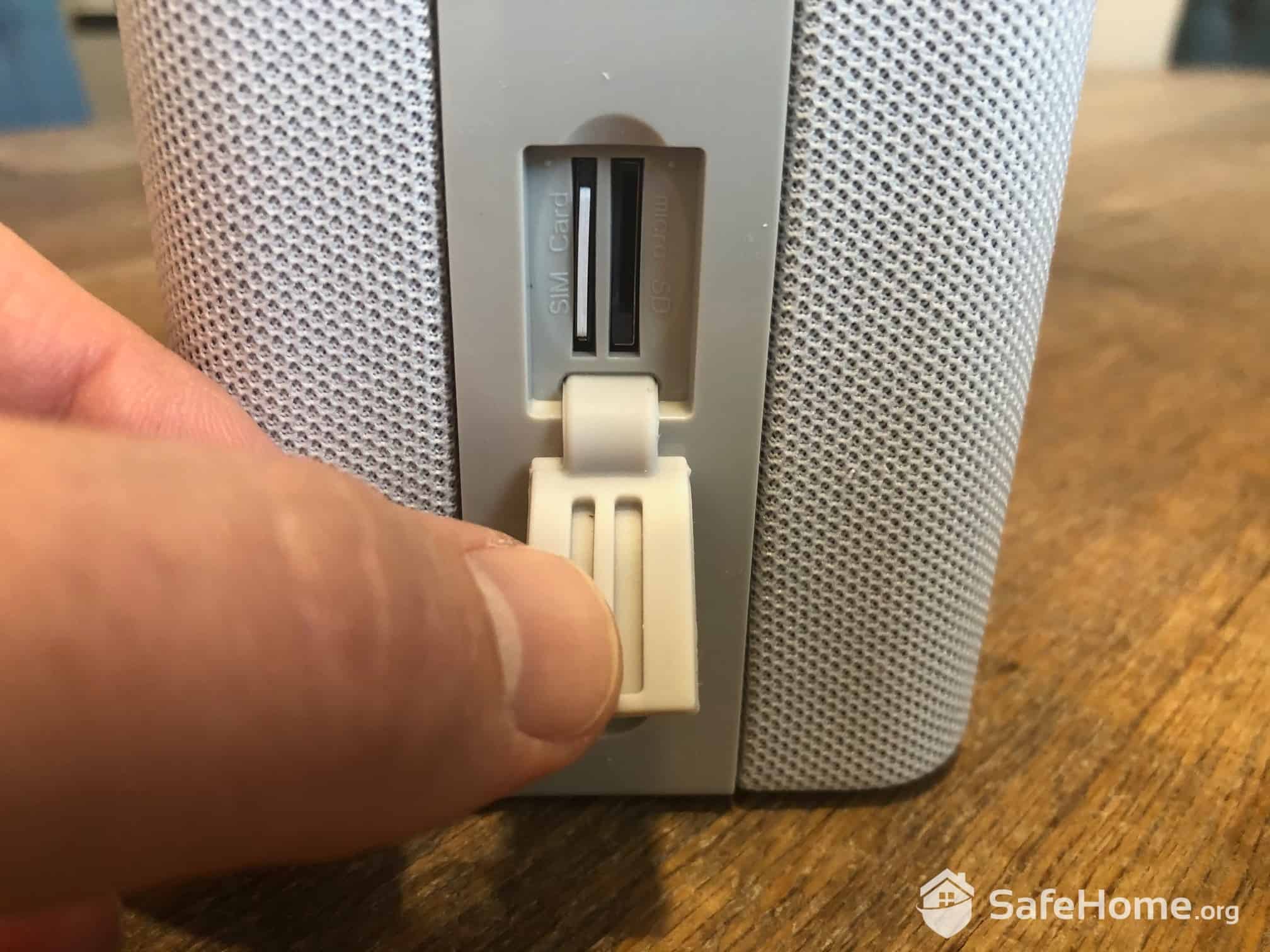
Back of abode Gateway
I only had to call in once to speak with an abode agent (during setup). I’m pretty sure abode’s support center is located in India, as the friendly abode rep had a thick Indian accent. This is neither good nor bad — it’s just the way they operate. What matters is that our abode rep spoke clear English and was able to help me when I needed assistance.
abode also has a fairly robust online support center, with an FAQ section, live chat, and troubleshooting guides. All things considered, abode makes the grade in the customer service department.
Did You Know? abode offers a 30-day return policy on equipment, plus a one-year warranty. Although these are customer-friendly policies, they’re also the industry standard these days.
This is a solid DIY home security system, with just a couple of caveats. First, if you’re wanting touch-screen controls, you won’t find them here. And if you’re not willing to spend at least $350 to $400 for equipment, and $21.99 per month for their Pro package, then I really don’t think it’s worth it.
That said, if you are willing to spend a little extra for equipment and monitoring, I think you’ll really like any of abode’s three home security kits, combined with their Pro plan. This will give you around-the-clock home protection from their professional monitoring center, video support, and best of all, a whole world of smart home automations with CUE.
We start our testing process with extensive research to identify home security options that meet our standards for features, pricing, and equipment. Once we’ve made a selection, we either install the systems ourselves — which was the case with abode — or have a professional technician set them up, depending on the system’s installation process.
Once the system is in place, we thoroughly evaluate its features, performance, and hardware capabilities. To gauge the system’s effectiveness in protecting against potential break-ins, we simulate various scenarios, such as burglary, home invasion, and break-ins. We also rate the performance of security cameras in monitoring for burglars and package thieves, and we also assess response times if professional monitoring services are available.
Our team of home security experts typically spends weeks testing each security system, with some systems undergoing testing for over a month. This extended testing period enables us to not only evaluate the system’s functionality but also to assess its compatibility with our daily lives. This way, we can recommend home security systems that would fit into the different lifestyles of our readers.
Yes, abode offers 24/7 professional monitoring with cellular backup, but only on their Pro plan.
No, abode offers month-to-month monitoring. No contracts are required.
The iota Gateway is the better choice, as it comes with a built-in HD camera with motion detection. Besides that feature, the Gen 2 Gateway and the iota Gateway function the same.
abode offers a 30-day return policy on equipment, which is standard for the industry.
Yes, abode offers easy DIY installation. Just be sure to follow the step-by-step instructions in the app.
Merriam-Webster. (2021). iota. https://www.merriam-webster.com/dictionary/iota
Spectrum Enterprise. (2020). What is the difference between a WiFi and Ethernet connection?
https://enterprise.spectrum.com/support/faq/network/what-is-the-difference-between-wifi-and-ethernet-connection.html
If This, Then That. (2020). https://ifttt.com/
Goabode.com. (2020). Meet Abode CUE. https://goabode.com/smart-home/cue
CIO.com. (2020). What is Geofencing? https://www.cio.com/article/2383123/geofencing-explained.html